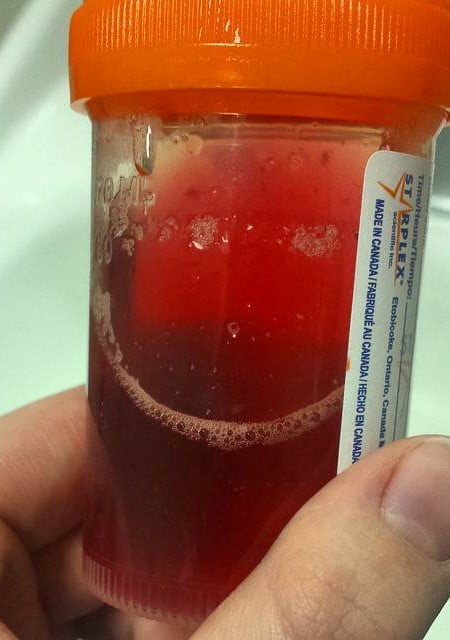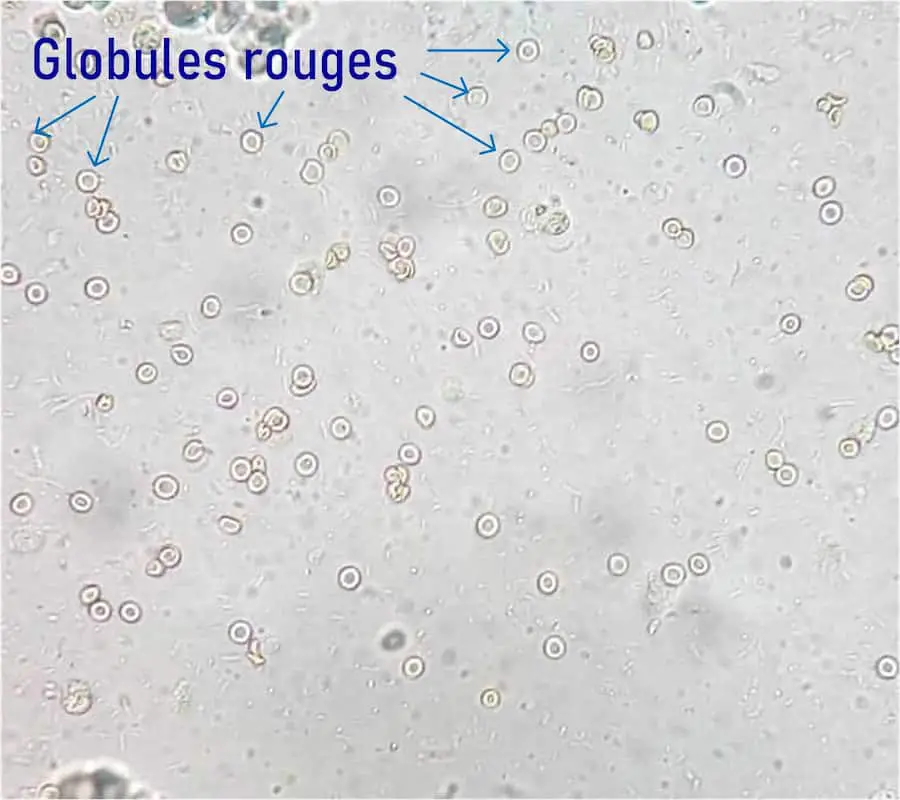Content
Haematuria is the medical term used to describe the presence of blood in urine. It can be visible to the naked eye or detected only by laboratory tests. In this article, we will explore the possible causes, symptoms, diagnosis, and available treatment for hematuria.
◉ Having blood in urine
Although the presence of blood in urine, known by the medical term of hematuria, is often caused by benign factors, it can also be a sign of a serious medical condition.
The presence of red blood cells in urine can result from bleeding in certain areas of the urinary tract. This may be due to the presence of kidney stones, certain infections, the use of a blood thinner, or an inherited or acquired bleeding disorder.
- When the blood present in the urine is in very small quantities and detected only by urine tests or under a microscope, it is called microscopic haematuria.
- In other cases, the blood is visible to the naked eye and is then called gross haematuria.
It is important to consult a healthcare professional if you observe blood in your urine. This will identify the source of the bleeding and prescribe appropriate treatment.

Bloody urine sample
◉ Types of hematuria
Hematuria can be classified according to its presentation, its origin and according to the chronology of the appearance of blood in the urine:
1. Classification according to presentation
2. Classification according to origin
- Glomerular haematuria: In this case, blood in the urine is the result of abnormalities affecting the kidney glomeruli. It is often associated with other symptoms such as presence of protein in the urine, decreased kidney function and high blood pressure and characterized by the presence of dysmorphic red blood cells in the urine.
- Non-glomerular haematuria: Bleeding is caused by conditions in the upper or lower urinary tract, which are not related to the renal glomeruli. It is characterized by the presence of isomorphic red blood cells.
3. Classification according to chronology
- Initial hematuria: in this case, blood appears at the beginning of the urinary flow.
- Terminal hematuria: blood appears towards the end of the urinary stream.
- Total hematuria: in this case, blood is present throughout the urinary stream.
◉ What causes blood in urine?
◉ The presence of blood in the urine can be caused by a variety of etiologies, found along the entire genitourinary tract. This includes the kidneys, ureters, bladder, prostate (in men) and urethra.
- Renal causes of hematuria: Infections (pyelonephritis, tuberculosis, etc.), kidney stones (renal colic), kidney diseases (glomerulonephritis, polycystic kidney disease, IgA nephropathy, etc.), trauma (accident, sports injury, etc.) and kidney tumors
- Ureteral causes of hematuria: Calculus, stricture, trauma, tumors, etc.
- Bladder causes: Cystitis, interstitial cystitis, radiation, stones, tumors and trauma
- Prostatic causes: Prostatitis, BPH, cancer and trauma.
- Urethral causes: Infections, stones, trauma, stenosis, etc.
◉ Bleeding disorders can cause blood vessels to become fragile, making it easier to bleed into different parts of the urinary system. Among these disorders:
- Decreased number of blood platelets (Thrombocytopenia), which may lead to insufficient clotting.
- Abnormalities in blood platelet function can render clotting ineffective (such as Bernard-Soulier syndrome)
- Hemophilia: A hereditary condition characterized by a total or partial deficiency of a coagulation factor.
- Blood-thinning medications (such as aspirin)
- Von Willebrand's disease: An inherited condition that affects the blood's ability to form clots.
◉ Blood may appear to be in the urine when it is actually coming from other sources, such as:
- Normal or abnormal vagina or uterine bleeding.
- Hemospermia (blood in the semen), due to a prostate problem.
- Saddles
◉ The presence of red urine does not always mean that there are red blood cells in the urine. There are several other possible causes that can give urine a red tint:
- Certain foods, such as beets, berries, and some food colorings.
- Certain medications, such as rifampicin or certain anthraquinone laxatives.
- Porphyria, urine may take on a red to brownish-red color.
- Paroxysmal nocturnal hemoglobinuria, red or brown urine noticed late at night or early in the morning.
◉ Diagnosis
It is important to see a doctor for a proper diagnosis and evaluation. The diagnosis of hematuria usually involves the following steps:
Anamnesis
The doctor will use the information gathered during the history to help formulate an accurate diagnosis:
- Medical history: kidney disease, kidney stones, recurrent urinary tract infections, cancers or hematological disorders.
- Description of symptoms: color of urine, frequency, duration, timing of bleeding.
- Associated symptoms: he will look for other clinical symptoms, in particular urinary symptoms (pain or burning during urination, urinary urgency, urinary incontinence )
- Other relevant information: he will look for a possible risk factor, a possible triggering factor, a history of recent trauma, the use of certain medications or the consumption of certain foods.
Physical examination
A physical examination may be performed to assess general health and look for any signs or symptoms that may suggest the cause of hematuria.
Urine analysis
There are several methods to detect the presence of blood in urine, including:
1- Urine dipstick test
The urine dipstick test is one of the most common methods used to detect the presence of blood in urine.
- Wash your hands thoroughly and then your genital area with soap and water.
- Start urinating into the toilet, then stop and place the sterile collection container under your urine stream.
- Collect at least 30 milliliters of urine in the container, then finish urinating in the toilet. Remove one strip from its packaging.
- Soak the strip in the urine sample for the recommended time (usually a few seconds).
- Remove the test strip from the urine and tap it gently to remove excess urine.
- Wait the recommended time (60sec) for the test results to develop.
The test is read by comparing the color of the test strip to a color chart provided by the manufacturer.

2- Microscopic analysis
Microscopic analysis can detect red blood cells in urine and assess their morphology (isomorphic or dysmorphic), which can provide additional information on the origin of hematuria.
A red blood cell is usually a pale yellow disc-shaped cell, 6 to 8 μm in diameter and with a dimple in the center. Its morphology varies depending on urine properties such as osmotic pressure and pH as well as the site of bleeding.

Urinary red blood cells under microscope
3- Automatic urine analyzer
Automated detection of blood in urine can be performed using specialized laboratory instruments. These instruments use different techniques to detect and quantify the presence of blood objectively and accurately.
Additional tests
Depending on the results of the urinalysis and other symptoms presented by the patient, additional investigations such as blood tests, ultrasounds, CT scans, cystoscopies or kidney biopsy may be recommended.
◉ Treatment
Once the cause of the blood in your urine has been identified, your doctor will begin treatment for that specific condition. They will then reassess you to determine if the blood is gone. If blood is still present in your urine, further tests may be needed or you may be referred to a specialist such as a urologist or nephrologist.
There are several treatment options for hematuria:
- Antibiotics: if a urinary tract infection is responsible for blood in the urine.
- Medical treatment of cause eg alpha-blockers may be prescribed to relieve symptoms and reduce prostate size in BPH.
- Management of kidney or bladder stones
- Surgical treatment may be considered in certain situations: bladder cancer, large stones, etc.